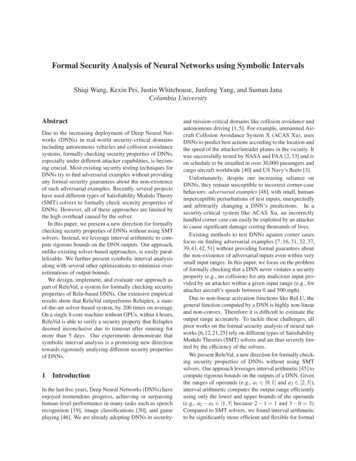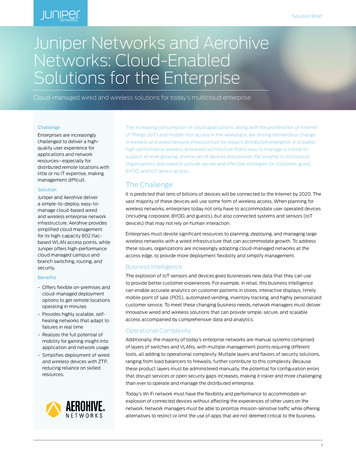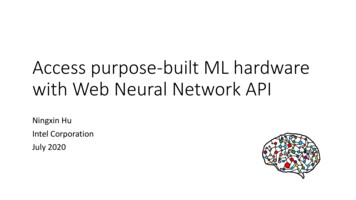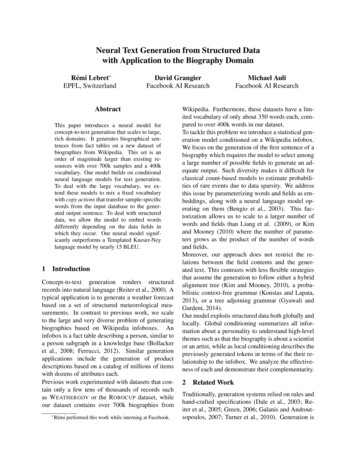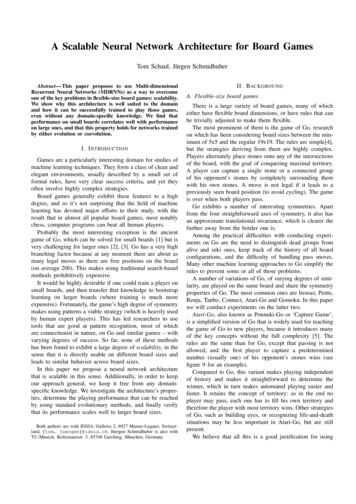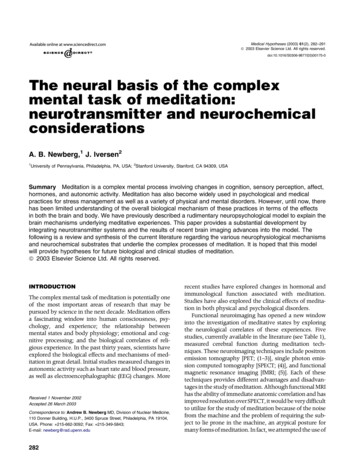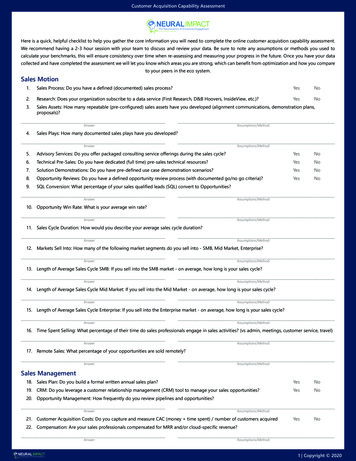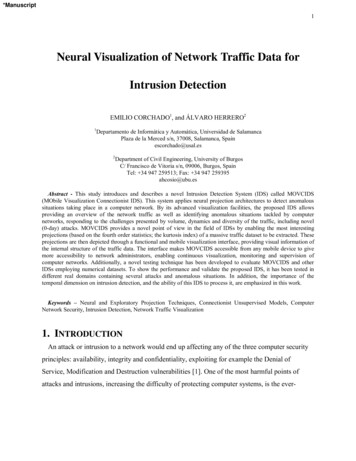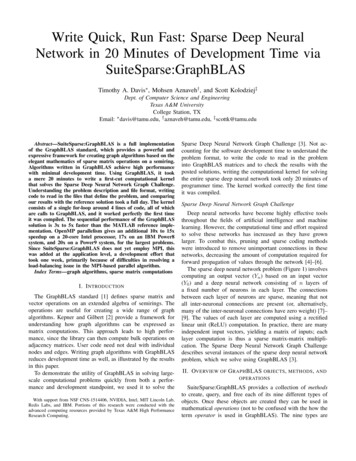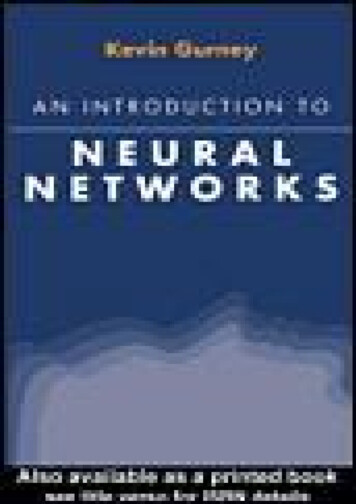
Transcription
An introduction to neural networksAn introduction to neural networksKevin GurneyUniversity of SheffieldLondon and New York Kevin Gurney 1997This book is copyright under the Berne Convention.No reproduction without permission.All rights reserved.First published in 1997 by UCL PressUCL Press Limited11 New Fetter LaneLondon EC4P 4EE2
UCL Press Limited is an imprint of the Taylor & Francis GroupThis edition published in the Taylor & Francis e-Library, 2004.The name of University College London (UCL) is a registered trade mark usedby UCL Press with the consent of the owner.British Library Cataloguing in Publication DataA catalogue record for this book is available from the British Library.ISBN 0-203-45151-1 Master e-book ISBNISBN 0-203-45622-X (MP PDA Format)ISBNs: 1-85728-673-1 (Print Edition) HB1-85728-503-4 (Print Edition) PBCopyright 2003/2004 Mobipocket.com. All rights reserved.Reader's GuideThis ebook has been optimized for MobiPocket PDA.Tables may have been presented to accommodate this Device's Limitations.Table content may have been removed due to this Device's Limitations.Image presentation is limited by this Device's Screen resolution.All possible language characters have been included within the Font handlingability of this Device.3
ContentsPreface1 Neural networks—an overview1.1 What are neural networks?1.2 Why study neural networks?1.3 Summary1.4 Notes2 Real and artificial neurons2.1 Real neurons: a review2.2 Artificial neurons: the TLU2.3 Resilience to noise and hardware failure2.4 Non-binary signal communication2.5 Introducing time2.6 Summary2.7 Notes3 TLUs, linear separability and vectors3.1 Geometric interpretation of TLU action3.2 Vectors3.3 TLUs and linear separability revisited3.4 Summary3.5 Notes4
4 Training TLUs: the perceptron rule4.1 Training networks4.2 Training the threshold as a weight4.3 Adjusting the weight vector4.4 The perceptron4.5 Multiple nodes and layers4.6 Some practical matters4.7 Summary4.8 Notes5 The delta rule5.1 Finding the minimum of a function: gradient descent5.2 Gradient descent on an error5.3 The delta rule5.4 Watching the delta rule at work5.5 Summary6 Multilayer nets and backpropagation6.1 Training rules for multilayer nets6.2 The backpropagation algorithm6.3 Local versus global minima6.4 The stopping criterion6.5 Speeding up learning: the momentum term6.6 More complex nets5
6.7 The action of well-trained nets6.8 Taking stock6.9 Generalization and overtraining6.10 Fostering generalization6.11 Applications6.12 Final remarks6.13 Summary6.14 Notes7 Associative memories: the Hopfield net7.1 The nature of associative memory7.2 Neural networks and associative memory7.3 A physical analogy with memory7.4 The Hopfield net7.5 Finding the weights7.6 Storage capacity7.7 The analogue Hopfield model7.8 Combinatorial optimization7.9 Feedforward and recurrent associative nets7.10 Summary7.11 Notes8 Self-organization6
8.1 Competitive dynamics8.2 Competitive learning8.3 Kohonen's self-organizing feature maps8.4 Principal component analysis8.5 Further remarks8.6 Summary8.7 Notes9 Adaptive resonance theory: ART9.1 ART's objectives9.2 A hierarchical description of networks9.3 ART19.4 The ART family9.5 Applications9.6 Further remarks9.7 Summary9.8 Notes10 Nodes, nets and algorithms: further alternatives10.1 Synapses revisited10.2 Sigma-pi units10.3 Digital neural networks10.4 Radial basis functions10.5 Learning by exploring the environment7
10.6 Summary10.7 Notes11 Taxonomies, contexts and hierarchies11.1 Classifying neural net structures11.2 Networks and the computational hierarchy11.3 Networks and statistical analysis11.4 Neural networks and intelligent systems: symbols versus neurons11.5 A brief history of neural nets11.6 Summary11.7 NotesA The cosine functionReferencesIndex8
PrefaceThis book grew out of a set of course notes for a neural networks module given aspart of a Masters degree in "Intelligent Systems". The people on this course camefrom a wide variety of intellectual backgrounds (from philosophy, throughpsychology to computer science and engineering) and I knew that I could not counton their being able to come to grips with the largely technical and mathematicalapproach which is often used (and in some ways easier to do). As a result I wasforced to look carefully at the basic conceptual principles at work in the subjectand try to recast these using ordinary language, drawing on the use of physicalmetaphors or analogies, and pictorial or graphical representations. I was pleasantlysurprised to find that, as a result of this process, my own understanding wasconsiderably deepened; I had now to unravel, as it were, condensed formaldescriptions and say exactly how these were related to the "physical" world ofartificial neurons, signals, computational processes, etc. However, I was acutelyaware that, while a litany of equations does not constitute a full description offundamental principles, without some mathematics, a purely descriptive accountruns the risk of dealing only with approximations and cannot be sharpened up togive any formulaic prescriptions. Therefore, I introduced what I believed was justsufficient mathematics to bring the basic ideas into sharp focus.To allay any residual fears that the reader might have about this, it is useful todistinguish two contexts in which the word "maths" might be used. The first refersto the use of symbols to stand for quantities and is, in this sense, merely ashorthand. For example, suppose we were to calculate the difference between atarget neural output and its actual output and then multiply this difference by aconstant learning rate (it is not important that the reader knows what these termsmean just now). If t stands for the target, y the actual output, and the learning rate isdenoted by a (Greek "alpha") then the output-difference is just (t-y) and the verbosedescription of the calculation may be reduced to (t-y). In this example the symbolsrefer to numbers but it is quite possible they may refer to other mathematicalquantities or objects. The two instances of this used here are vectors and functiongradients. However, both these ideas are described at some length in the mainbody of the text and assume no prior knowledge in this respect. In each case, onlyenough is given for the purpose in hand; other related, technical material may havebeen useful but is not considered essential and it is not one of the aims of this bookto double as a mathematics primer.The other way in which we commonly understand the word "maths" goes one stepfurther and deals with the rules by which the symbols are manipulated. The onlyrules used in this book are those of simple arithmetic (in the above example wehave a subtraction and a multiplication). Further, any manipulations (and there9
aren't many of them) will be performed step by step. Much of the traditional "fearof maths" stems, I believe, from the apparent difficulty in inventing the rightmanipulations to go from one stage to another; the reader will not, in this book, becalled on to do this for him- or herself.One of the spin-offs from having become familiar with a certain amount ofmathematical formalism is that it enables contact to be made with the rest of theneural network literature. Thus, in the above example, the use of the Greek lettermay seem gratuitous (why not use a, the reader asks) but it turns out that learningrates are often denoted by lower case Greek letters and a is not an uncommonchoice. To help in this respect, Greek symbols will always be accompanied bytheir name on first use.In deciding how to present the material I have started from the bottom up bydescribing the properties of artificial neurons (Ch. 2) which are motivated bylooking at the nature of their real counterparts. This emphasis on the biology isintrinsically useful from a computational neuroscience perspective and helpspeople from all disciplines appreciate exactly how "neural" (or not) are thenetworks they intend to use. Chapter 3 moves to networks and introduces thegeometric perspective on network function offered by the notion of linearseparability in pattern space. There are other viewpoints that might have beendeemed primary (function approximation is a favourite contender) but linearseparability relates directly to the function of single threshold logic units (TLUs)and enables a discussion of one of the simplest learning rules (the perceptron rule)i n Chapter 4. The geometric approach also provides a natural vehicle for theintroduction of vectors. The inadequacies of the perceptron rule lead to adiscussion of gradient descent and the delta rule (Ch. 5) culminating in adescription of backpropagation (Ch. 6). This introduces multilayer nets in full andis the natural point at which to discuss networks as function approximators, featuredetection and generalization.This completes a large section on feedforward nets. Chapter 7 looks at Hopfieldnets and introduces the idea of state-space attractors for associative memory and itsaccompanying energy metaphor. Chapter 8 is the first of two on self-organizationand deals with simple competitive nets, Kohonen self-organizing feature maps,linear vector quantization and principal component analysis. Chapter 9 continuesthe theme of self-organization with a discussion of adaptive resonance theory(ART). This is a somewhat neglected topic (especially in more introductory texts)because it is often thought to contain rather difficult material. However, a novelperspective on ART which makes use of a hierarchy of analysis is aimed at helpingthe reader in understanding this worthwhile area. Chapter 10 comes full circle andlooks again at alternatives to the artificial neurons introduced in Chapter 2. It alsobriefly reviews some other feedforward network types and training algorithms so10
that the reader does not come away with the impression that backpropagation has amonopoly here. The final chapter tries to make sense of the seemingly disparatecollection of objects that populate the neural network universe by introducing aseries of taxonomies for network architectures, neuron types and algorithms. It alsoplaces the study of nets in the general context of that of artificial intelligence andcloses with a brief history of its research.The usual provisos about the range of material covered and introductory textsapply; it is neither possible nor desirable to be exhaustive in a work of this nature.However, most of the major network types have been dealt with and, while thereare a plethora of training algorithms that might have been included (but weren't) Ibelieve that an understanding of those presented here should give the reader a firmfoundation for understanding others they may encounter elsewhere.11
Chapter OneNeural networks—an overviewThe term "Neural networks" is a very evocative one. It suggests machines that aresomething like brains and is potentially laden with the science fiction connotationsof the Frankenstein mythos. One of the main tasks of this book is to demystify neuralnetworks and show how, while they indeed have something to do with brains, theirstudy also makes contact with other branches of science, engineering andmathematics. The aim is to do this in as non-technical a way as possible, althoughsome mathematical notation is essential for specifying certain rules, procedures andstructures quantitatively. Nevertheless, all symbols and expressions will beexplained as they arise so that, hopefully, these should not get in the way of theessentials: that is, concepts and ideas that may be described in words.This chapter is intended for orientation. We attempt to give simple descriptions ofwhat networks are and why we might study them. In this way, we have something inmind right from the start, although the whole of this book is, of course, devoted toanswering these questions in full.12
1.1 What are neural networks?Let us commence with a provisional definition of what is meant by a "neuralnetwork" and follow with simple, working explanations of some of the key terms inthe definition.A neural network is an interconnected assembly of simple processing elements, units or nodes, whosefunctionality is loosely based on the animal neuron. The processing ability of the network is stored in the interunitconnection strengths, or weights, obtained by a process of adaptation to, or learning from, a set of trainingpatterns.To flesh this out a little we first take a quick look at some basic neurobiology. Thehuman brain consists of an estimated 1011 (100 billion) nerve cells or neurons, ahighly stylized example of which is shown in Figure 1.1. Neurons communicate viaelectrical signals that are short-lived impulses or "spikes" in the voltage of the cellwall or membrane. The interneuron connections are mediated by electrochemicaljunctions called synapses, which are located on branches of the cell referred to asdendrites. Each neuron typically receives many thousands of connections fromFigure 1.1 Essential components of a neuron shown in stylized form.other neurons and is therefore constantly receiving a multitude of incoming signals,which eventually reach the cell body. Here, they are integrated or summed togetherin some way and, roughly speaking, if the resulting signal exceeds some thresholdthen the neuron will "fire" or generate a voltage impulse in response. This is thentransmitted to other neurons via a branching fibre known as the axon.In determining whether an impulse should be produced or not, some incomingsignals produce an inhibitory effect and tend to prevent firing, while others areexcitatory and promote impulse generation. The distinctive processing ability ofeach neuron is then supposed to reside in the type—excitatory or inhibitory—andstrength of its synaptic connections with other neurons.13
It is this architecture and style of processing that we hope to incorporate in neuralnetworks and, because of the emphasis on the importance of
constant learning rate (it is not important that the reader knows what these terms mean just now). If t stands for the target, y the actual output, and the learning rate is denoted by a (Greek "alpha") then the output-difference is just (t-y) and the verbose description of the calculation may be reduced to (t-y). In this example the symbols refer to numbers but it is quite possible they may .
